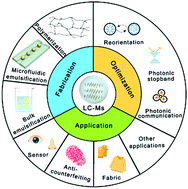Development in liquid crystal microcapsules: fabrication, optimization and applications
Abstract
A liquid crystal (LC) is an intermediate phase between a liquid and solid whose molecular orientation can be well-ordered, but the shape of the bulk LC material is like a flow. As the elastic force between the LC molecules is weak, the orientation is easily controllable by external stimuli including an electric field, light, and temperature, and thus modulates the optical properties, making them promising for various optical applications. However, the stability and versatility of LCs are severely limited by their fluidity. A series of modified LC materials such as LC polymers and LC elastomers have been designed to overcome their limitation. But the intrinsic stimuli-responsive property of LCs is severely reduced by the polymer matrix. In order to further improve the stability while maintaining the responsive property, the polymer matrix and LCs are separated to fabricate LC microcapsules (LC-Ms), which are composed of inner LC cores and outer polymer shells. This article reviews the fabrication methods, properties and applications of LC-Ms. We first discuss the emulsification and shell formation of LC-Ms, after which we introduce their intrinsic performance as well as their optimization strategies. We then illustrate three representative applications – in sensing, anti-counterfeiting, and smart fabrics. Finally, the current challenges and potential development directions of LC-Ms are introduced briefly.



 Please wait while we load your content...
Please wait while we load your content...